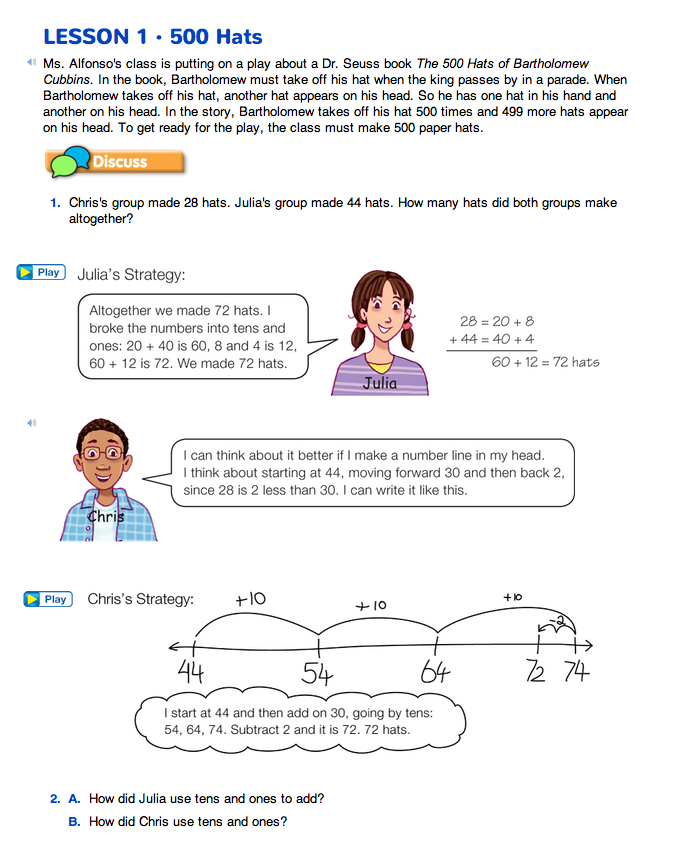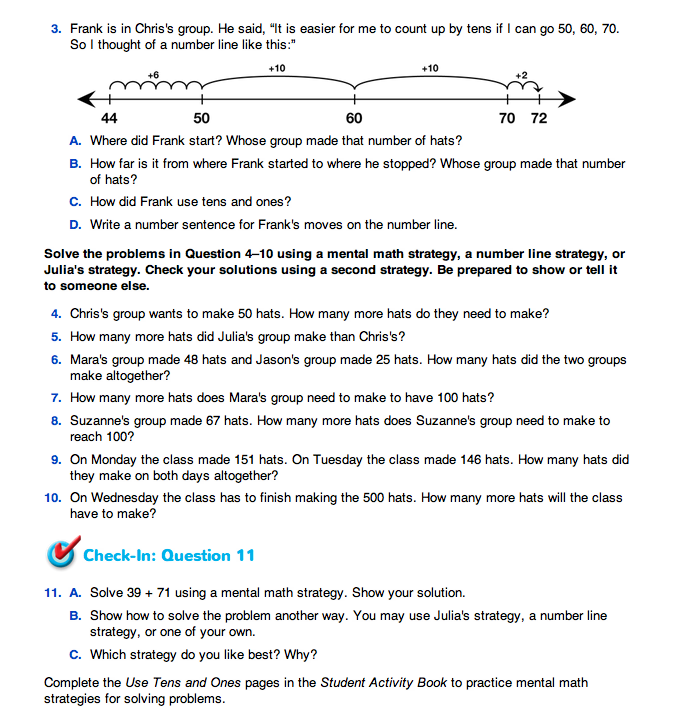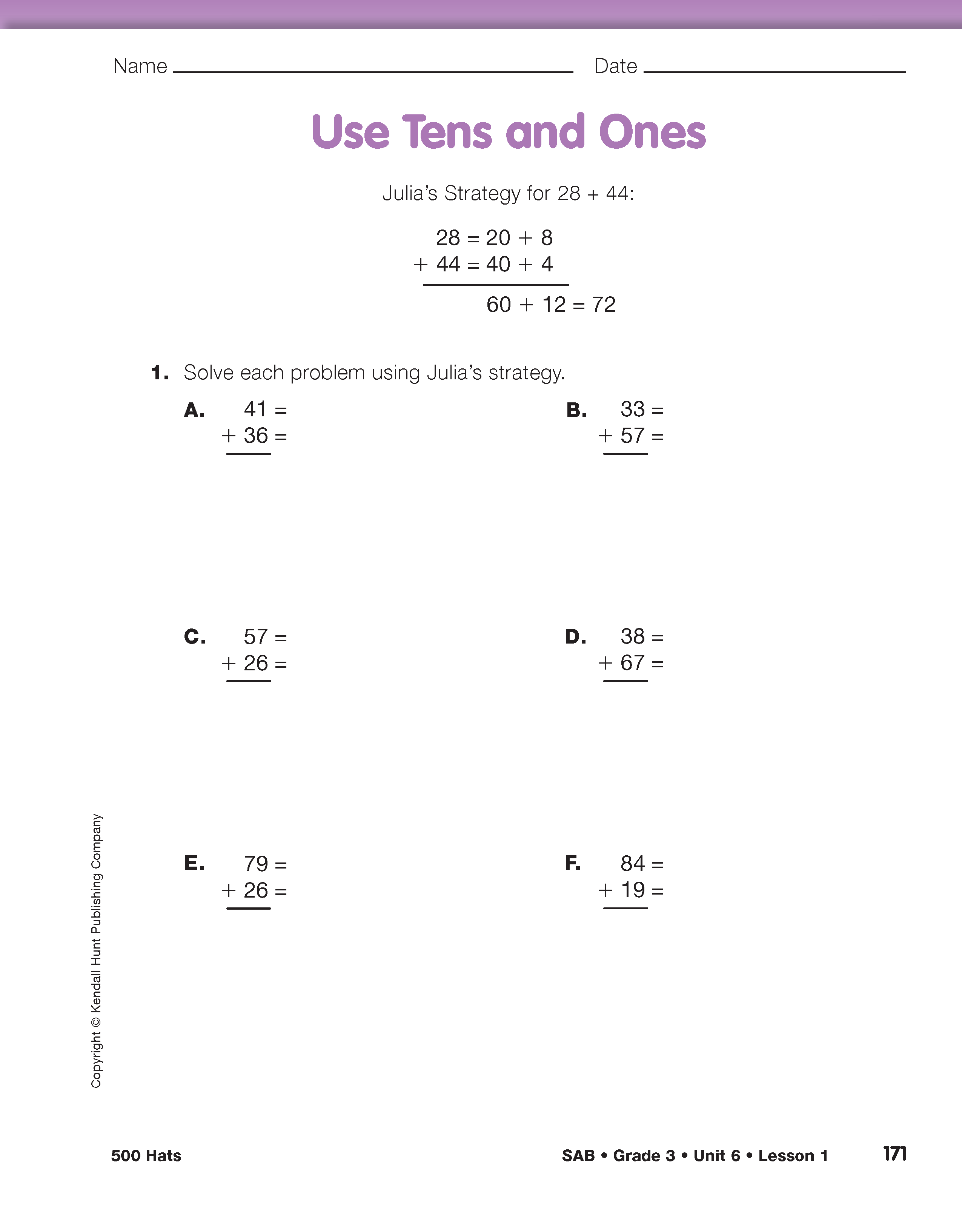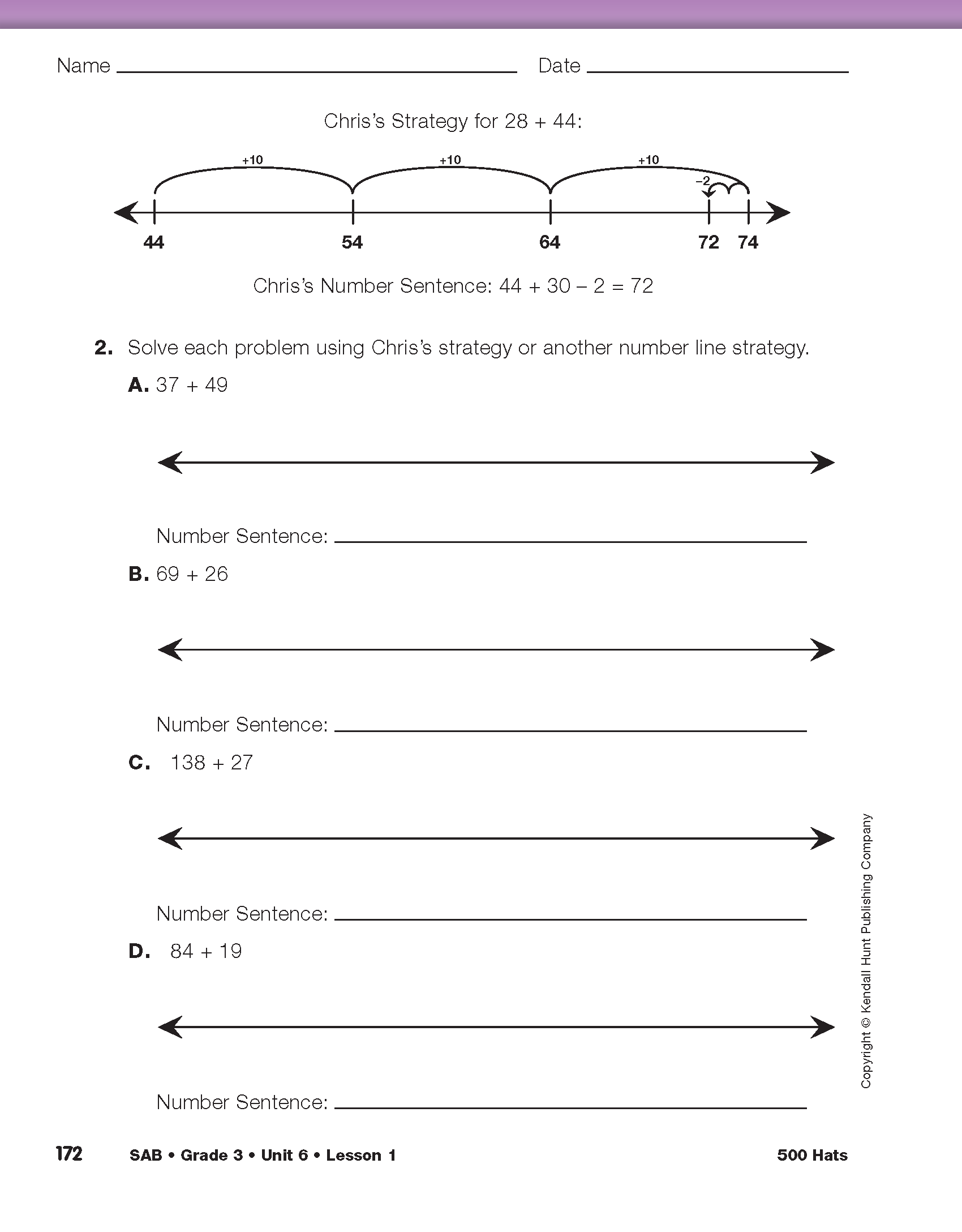Read the Story. Read aloud the Dr. Seuss book The 500 Hats of Bartholomew Cubbins or briefly tell the story to the class.
If you choose to read the story aloud, the following questions can be used while reading:
- When Sir Alaric says that 154 hats had already come off, how many hats had come off since the king had called for Sir Snipps, the hat maker?
- When Bartholomew says the executioner had knocked off 13 hats and that he had left 178 more on the dungeon steps, how many hats was he talking about altogether?
- When the hats begin to change, 450 hats had already come off. Based on the book's title, how many hats are left on Bartholomew's head?
Make up problems that refer to the story's plot. For example:
- When he had taken off 275 hats, how many more hats would eventually appear on his head?
- If 45 hats blew off before he got to the castle, and 205 more came off before he reached the dungeon, how many hats had he lost?
- At one point Bartholomew said that he had thrown off 180 hats. If he had already lost 150 hats earlier, how many hats had he lost at this point?
- Bartholomew lost 330 hats. He lost 120 more hats before they started changing. How many simple red hats did he lose before they started changing?
Provide additional practice similar to the problems suggested as prompts. Ask students to write and solve addition and subtraction problems based on the Dr. Seuss story or another story of their choice. See the Unit Resources in the Unit Overview for other titles.
Share Addition Strategies. After reading the story or sharing the plot, ask students to read the first paragraph on the first 500 Hats page in the Student Guide. Tell them that a third-grade class is going to put on a play of the story, so the class needs to make 500 hats.
Students will solve problems about the 500 hats in the school play. They will learn strategies for adding in their heads and using number lines. While they are learning and sharing strategies, it will help to write down what they are thinking.
Ask students to work together to solve Question 1 before reading Julia's and Chris's strategies in the Student Guide.
Encourage students to find ways to solve the problem using mental math or their desk number lines. Remind them that they should be prepared to share their strategies with the class. Tell them they can make notes on scrap paper or sketch a number line.
Using a number line gives students a visual support to keep track of mental jumps when solving multidigit problems and shows how our number system is organized. Helping students visualize the partitions and operations leads to the development of efficient mental strategies.

Facilitating a classroom discussion is an art and depends on the teacher's knowledge of his or her students. As you work with your students, use the following tips as appropriate:
- When students answer questions about their strategies, ask clarifying questions so the strategy can be understood by others. For example, if a student answers that he or she used the number line, ask how it was used. What moves were made? Ask another student to explain the first student's strategy in his or her own words or to solve a similar problem using the same strategy.
- Talking about one problem for a long time can reduce students' interest in the problem and strategies. There are ample problems to discuss in the lesson, so move on to another problem to bring out other possible strategies.
- Give students plenty of time and the freedom to develop their own strategies before discussing others.
- Discuss some of the problems as a whole group and others with students as they work with partners or in small groups. This will allow students to move to the next problem when they are ready or to spend more time on a single problem for an extended period of time when needed.
Compare Addition Strategies. When students have solved the problem, ask a few partners to show or tell their strategies to the class. They should record their solutions on chart paper, the board, or other display and label their strategies with their names so the solutions can be used in a class discussion.
Ask students to study Julia's and Chris's strategies and to discuss Question 2 with their partners.
As students work together, ask them to compare the strategies using prompts similar to the following:
- How did Julia use tens and ones? (She broke each number into tens and ones. First she added the tens and then she added the ones. Then it was easy to add them together.)
- How did Chris use tens and ones? (Chris used a number line. He knew that 28 was close to 30, so he first added 30 to 44 by skip counting by tens. Then he went back two.)
- Are any of the strategies that we discussed like Julia's or Chris's? How are they alike? How are they different?
- Did you use tens and ones when you added 44 and 28? If so, how?
- Did you take the numbers apart and put them back together? If so, how?
- What did you “see” in your head?
- Did you use your desk number line? If so, how?
- Do any of the solutions written on the board use tens and ones? How?
- Which of the strategies are the easiest to use or understand? Why do you think so?
- Which are the most efficient?
After providing adequate time for students to work, briefly conduct a whole class discussion highlighting the similarities and differences in Julia's and Chris's strategies. Ask various students to share how they used tens and ones, number lines, and what they visualized in their heads. Also elicit from students which strategies were easiest to understand and use and which they thought were most efficient.
Use a Number Line. Discuss Frank's strategy in Question 3 using discussion prompts similar to those for Question 2. Then ask students to answer Questions 4–11. Encourage them to try new methods and to check their solutions using a second solution strategy.
Emphasize partitioning numbers and using mental strategies, such as partitioning and combining, doubling, using complements of ten and a hundred, or skip counting. Circulate as students work and ask them to explain their thinking.
Use prompts similar to the following as appropriate to each question:
- Can you use tens and ones (or hundreds, tens, and ones) to solve this problem?
- How could you use doubling to help you solve this problem?
- Would skip counting help with this problem?
- What mental strategy is easiest for you to use in this problem?
Encourage students to write number sentences to describe the different problems. Do not discourage students from using pencil-and-paper algorithms to solve any problems. Keep in mind, however, that the goal of this activity is to engage students in using their own mental math strategies rather than to teach them formal procedures. Give students opportunities to share their strategies for solving problems with the class.
Use Check-In: Question 11 in the Student Guide to assess students' progress toward representing and solving addition problems using number lines [E2] and using mental math strategies or paper-and-pencil methods [E3] and [E4].
Use the Workshop in Lesson 6 to provide targeted practice.
Use Tens and Ones. Assign Questions 1–2 on the Use Tens and Ones pages in the Student Activity Book. Question 1 asks students to use Julia's strategy (using expanded form) of decomposing and composing numbers using tens and ones. Question 2 asks them to use the number line to support their counting strategies.
Provide time for students to work on the questions and compare solutions. Tell them to explain their strategies clearly so that others can understand their thinking. Ask several students to share solutions with the whole class for a few problems comparing similarities and differences in their strategies.
Choose from the following prompts:
- How are the strategies similar?
- How are the strategies different?
- How were tens and ones used in each strategy?
- Were number lines used differently? How?
- Which strategy seemed the most efficient?



















